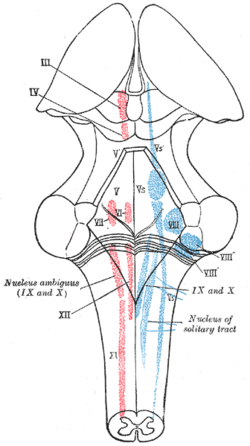Mesencephalic nucleus of trigeminal nerve
| Mesencephalic nucleus of trigeminal nerve | |
|---|---|
 The cranial nerve nuclei schematically represented; dorsal view. Motor nuclei in red; sensory in blue. (Trigeminal nerve nuclei are at "V".) | |
| Details | |
| Identifiers | |
| Latin | nucleus mesencephalicus nervi trigemini |
| NeuroNames | 558 |
NeuroLex ID | birnlex_1010 |
| TA | A14.1.05.409 |
| FMA | 54568 |
Anatomical terms of neuroanatomy [edit on Wikidata] | |
The mesencephalic nucleus is involved with reflex proprioception of the periodontium [1] and of the muscles of mastication in the jaw[2] that functions to prevent biting down hard enough to lose a tooth. To subserve this reflex protective function, mechanoreceptive nerves in the periodontal ligament sense tooth movement and project to the mesencephalic nucleus. Likewise, afferent fibers from muscle spindles, the sensory organs of skeletal muscle, are stimulated by the stretch of hard contraction of jaw muscles. The temporomandibular joints and the Golgi tendon organs of the jaw muscles do not project to the mesencephalic nucleus.[3] The mesencephalic nucleus is one of four trigeminal nerve nuclei, three sensory and one motor. The other two sensory nuclei are the chief sensory nucleus mediating conscious facial touch and the spinal trigeminal nucleus, mediating pain in the head, and is of importance in headache. The trigeminal motor nucleus innervates the muscles of mastication.
Unlike many nuclei within the central nervous system (CNS), the mesencephalic nucleus contains no chemical synapses but are electrically coupled.[4] Neurons of this nucleus are unipolar cells that receive proprioceptive information from the mandible and send projections to the trigeminal motor nucleus to mediate monosynaptic jaw jerk reflexes. It is also the only structure in the CNS to contain first order sensory neurons, cell bodies of primary afferents in contact with the periphery, which are usually contained within ganglia (like the trigeminal ganglion). The mesencephalic nucleus can thus be considered functionally as a sensory ganglion embedded within the brainstem, making it neuroanatomically unique[citation needed].
Contents
1 Clinical significance
2 See also
3 References
4 External links
Clinical significance
Clinically, because of its reflex function, the mesencephalic nucleus can be tested with the jaw jerk reflex. Because of its function in oral proprioception, lesions of the trigeminal mesencephalic nucleus cause effects on feeding.[5] The mesencephalic nucleus can be thought of simply as the "nucleus that keeps your teeth in" by preventing one from biting down hard enough to lose a tooth on foods containing eg. bone, cherry seeds, apricot stones etc.
See also
- Trigeminocerebellar fibers
References
^ Shigenaga Y, Doe K, Suemune S, Mitsuhiro Y, Tsuru K, Otani K, Shirana Y, Hosoi M, Yoshida A, Kagawa K (1989). "Physiological and morphological characteristics of periodontal mesencephalic trigeminal neurons in the cat--intra-axonal staining with HRP". Brain Research. 505: 91–110. PMID 2611682..mw-parser-output cite.citation{font-style:inherit}.mw-parser-output q{quotes:"""""""'""'"}.mw-parser-output code.cs1-code{color:inherit;background:inherit;border:inherit;padding:inherit}.mw-parser-output .cs1-lock-free a{background:url("//upload.wikimedia.org/wikipedia/commons/thumb/6/65/Lock-green.svg/9px-Lock-green.svg.png")no-repeat;background-position:right .1em center}.mw-parser-output .cs1-lock-limited a,.mw-parser-output .cs1-lock-registration a{background:url("//upload.wikimedia.org/wikipedia/commons/thumb/d/d6/Lock-gray-alt-2.svg/9px-Lock-gray-alt-2.svg.png")no-repeat;background-position:right .1em center}.mw-parser-output .cs1-lock-subscription a{background:url("//upload.wikimedia.org/wikipedia/commons/thumb/a/aa/Lock-red-alt-2.svg/9px-Lock-red-alt-2.svg.png")no-repeat;background-position:right .1em center}.mw-parser-output .cs1-subscription,.mw-parser-output .cs1-registration{color:#555}.mw-parser-output .cs1-subscription span,.mw-parser-output .cs1-registration span{border-bottom:1px dotted;cursor:help}.mw-parser-output .cs1-hidden-error{display:none;font-size:100%}.mw-parser-output .cs1-visible-error{font-size:100%}.mw-parser-output .cs1-subscription,.mw-parser-output .cs1-registration,.mw-parser-output .cs1-format{font-size:95%}.mw-parser-output .cs1-kern-left,.mw-parser-output .cs1-kern-wl-left{padding-left:0.2em}.mw-parser-output .cs1-kern-right,.mw-parser-output .cs1-kern-wl-right{padding-right:0.2em}
^ Shigenaga Y, Mitsuhiro Y, Shirana Y, Tsuru H (1990). "Two types of jaw-muscle spindle afferents in the cat as demonstrated by intra-axonal staining with HRP". Brain Research. 514: 219–237. PMID 2357539.
^ Cody FW, Lee RW, Taylor A (1972). "A functional analysis of the components of the mesencephalic nucleus of the fifth nerve in the cat". Journal of Physiology. 226: 249–261. PMC 1331163. PMID 4263681.
^ Baker R, Llinás R (1971). "Electrotonic coupling between neurones in the rat mesencephalic nucleus". Journal of Physiology. 212 (1): 45–63. doi:10.1113/jphysiol.1971.sp009309. PMC 1395705. PMID 5545184.
^ Yokoyama, S; Kinoshita, K; Muroi, Y; Ishii, T (2013). "The effects of bilateral lesions of the mesencephalic trigeminal sensory nucleus on nocturnal feeding and related behaviors in mice". Life Sciences. 93: 681–686. doi:10.1016/j.lfs.2013.09.015. PMID 24063988.
External links
- Washington University

Comments
Post a Comment